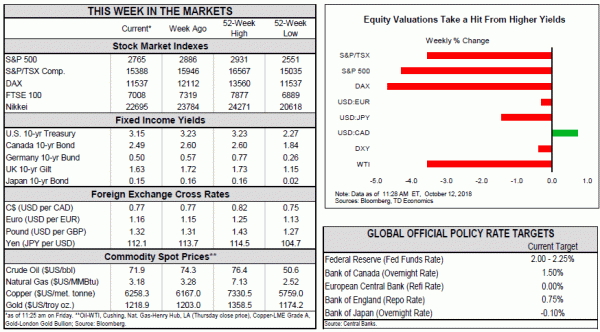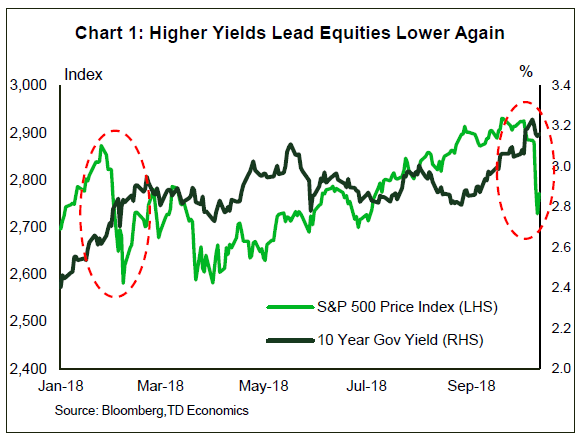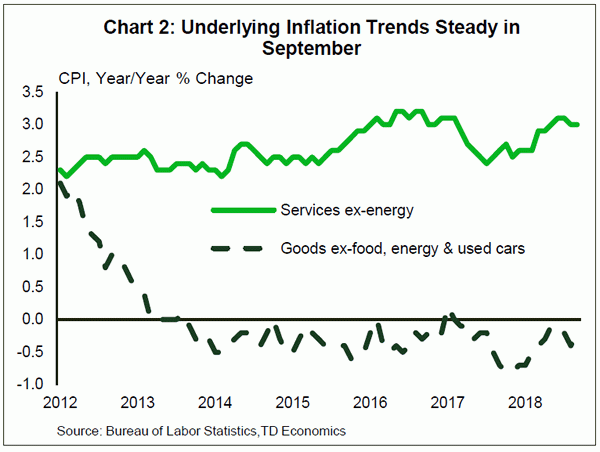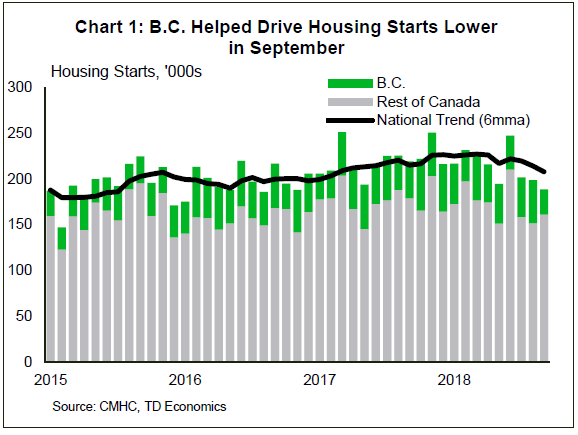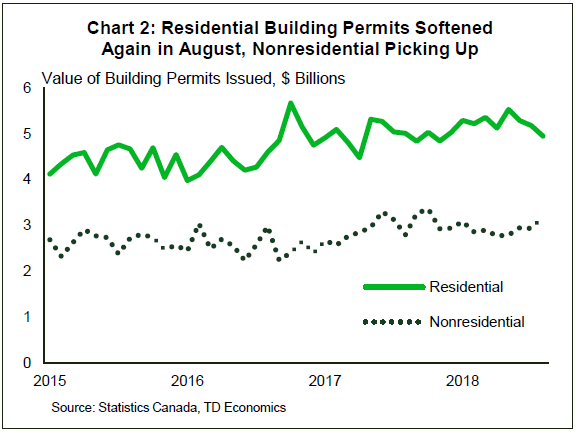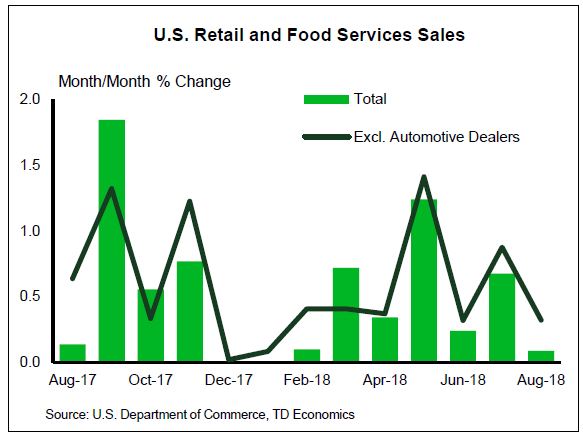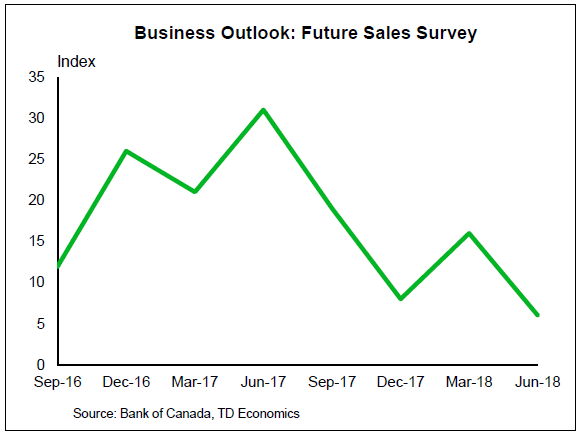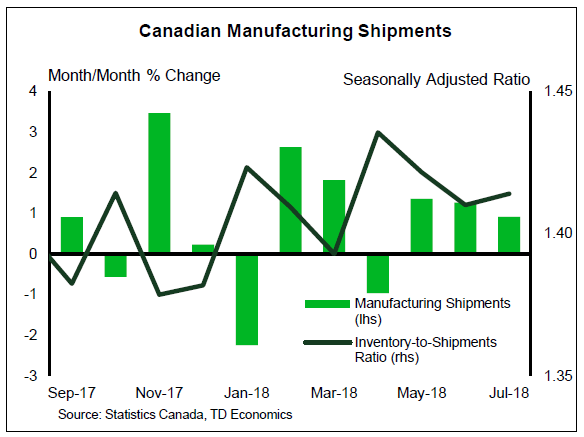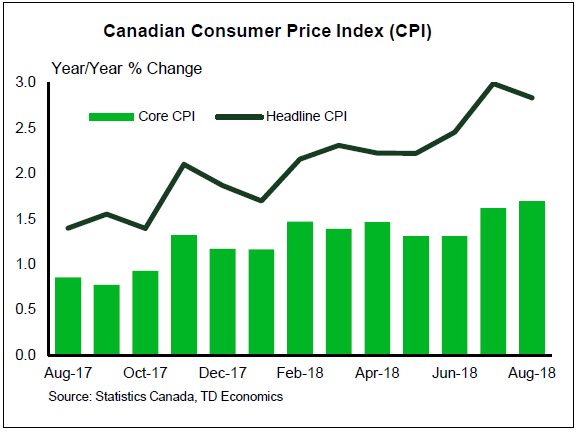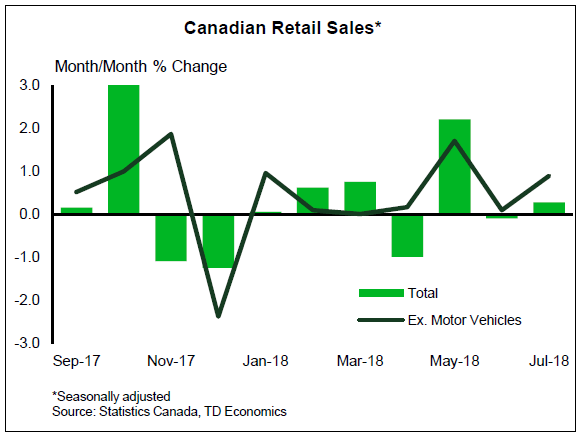U.S. Highlights
- The S&P500 has seen its biggest five-day loss since February this week. Much like then, higher bond yields have led to a repricing of stocks.
- There are few signs the U.S. economy is cooling. September consumer price inflation data showed that inflation pressures remain quite contained.
- On net, this argues for a continued gradual pace of rate hikes by the Fed. A severe tightening in financial conditions would put this at risk, but there is little evidence of that yet.
Canadian Highlights
- Canadian markets joined their global counterparts, tumbling lower as the week progressed. Fortunately, a modest recovery at Friday’s market open suggests that this week’s events may just be a market hiccup, rather than a signal of anything meaningful.
- A quiet data week saw housing starts and building permits released. Indicators of new housing activity continued to soften, but non-residential permits remain in an uptrend, a positive sign.
U.S. – Stocks Adjust to Higher Yields
The headline story this week has been the downturn in global equity markets. The S&P500 has fallen about 6% this past week, the biggest five-day loss since February. A bond market rout was the cause then, and it was behind the move in recent days too, as equities re-price to reflect the higher yield environment (Chart 1). This is not a bear market, which is a 20% drop for at least two months, or even a correction, which the market did experience back in February.
For its part, the U.S. economy continues to do well. Indeed, stocks have weakened in part because the economy is doing well. The Fed has clearly signaled they expect strong economic growth to continue, and expect to continue raising rates over the coming year. Bond markets are increasingly taking them at their word, and investors now require a higher yield to hold bonds. When analysts value equities, they discount the expected future cash flow or dividends, and with higher rates those discounted cash flows are looking less valuable, resulting in a repricing of stocks.
There are plenty of downside risks lurking around corners for the U.S. economy: negative impacts from increased tariffs; higher government deficits could lead to a further move up in Treasury yields; and the risk of a Fed policy error. But, at the moment it must be acknowledged that the U.S. economy is growing strongly, a healthy labor market is increasing the share of people with jobs, and wage gains are occurring. At the same time, inflation pressures remain very well behaved. That helps ensure the Fed can remain patient as it raises policy rates.
Further evidence was received this week that inflation pressures remained contained in September. The Consumer Price Index rose only 0.1% on the month both for the headline and core. Core inflation held steady at 2.2% year/year, within the range it has maintained since March. The story of core services inflation running around 3%, being offset by deflation in core goods remained unchanged (Chart 2). But, the cast of characters holding goods prices down on a month-to-month basis changed; in August it was apparel, in September, used cars. Still, the bottom line is that core goods have been firmly in deflationary territory for five years now. We had been expecting this to change, as the effects of past dollar appreciation wear off, but the more recent strength in the dollar will likely delay this. And, we haven’t seen much evidence yet of tariff impact at the consumer level.
Meanwhile, services inflation has picked up from its 2017 soft patch, but it hasn’t really broken new ground. We continue to expect a tight labor market, and increased wage pressures to lead core inflation higher over the next year. But, September’s inflation numbers provide reassurance that an undesirable sharper upturn is not occurring. We expect the Fed to continue raising rates a quarter point at every other meeting over the next year. It would take a much more severe tightening in financial conditions than recently observed to put this pace at risk.
Canada – Housing Handing Over The Reins?
All eyes were on markets this week. A relatively benign start to the shortened week gave way to significant declines in equity markets on Wednesday and Thursday. The S&P/TSX composite index shed roughly 3.5% of its value over these days as markets sold off around the world. Not helping in the Canadian context was a price for heavy crude oil (which makes up about half of Canadian production) that continued to fall and sat around the U.S. $20 per barrel mark at the time of writing.
A slew of ex-post justifications for the sell-off are now on offer, with the most plausible being that investors, particularly in the growth space, are beginning to take higher future interest rates into account. This restores, to a degree, the ‘normal’ link between bonds and equities. Why this realization came this week in particular is unclear. Rates have been on the rise for a while now and the Federal Reserve has not signalled any significant inclination towards slowing the pace of rate increases. Regardless, this week’s events so far seem to be a regular market ‘hiccup’, with major indices set for a positive end to the week at the time of writing (the TSX began Friday’s trading session roughly a percentage point above Thursday’s close).
Away from markets, the economic data this week was housing focused. Starts were off again in September, falling to 189k at an annualized pace. This was enough to bring the 6 month average trend down to a 19 month low (Chart 1). If there is any consolation to be taken from this disappointing number, it is that the decline can be almost entirely attributed to B.C., where housing markets continue to digest recent policy changes.
Still, there is no denying that the trend in housing activity, broadly speaking, is softening. This was confirmed in the building permit data for August, which showed a further weakening in the dollar value of residential permits approved (Chart 2). It of course bears noting that a moderation of housing markets is to be expected given the broader Canadian economic story. The policy interest rate has been moved up a full point over the last year or so, and further hikes seem likely. More expensive debt crimps household budgets, with housing the most obvious point of impact (other rate sensitive areas, like auto sales, have also been moderating).
As it stands, there doesn’t seem to be too much to get worried about. Resale activity has begun to pick back up after a policy-induced slowdown at the beginning of the year, which should, with time, incent further supply. What’s more, other areas of the Canadian economy are holding up well. Non-residential building permits remain in an uptrend, and USMCA removes some uncertainty from the near-term outlook (see report). Housing has been (and will continue to be) an important driver of the Canadian economy. But household finances are still stretched and interest rates are likely to continue rising. Clearly, the time has come for the reins to be passed to other growth areas.
U.S.: Upcoming Key Economic Releases
U.S. Retail Sales – September
Release Date: October 15, 2018
Previous: 0.1%, ex. auto: 0.3%,
TD Forecast: 0.9%, ex. auto: 0.4%
Consensus: 0.7%, ex. auto: 0.4%
We expect a 0.9% increase in retail sales, reflecting a strong boost from auto sales. Hurricane Florence could also lift certain categories like building materials this month consistent with past disaster episodes. This impact, along with healthy labor market fundamentals, point to a 0.5% rise in core sales with upside risk. The report would also underpin Q3 real PCE above 3%.
Canada: Upcoming Key Economic Releases
Business Outlook Survey – October
Release Date: October 15, 2018
The Autumn Business Outlook Survey will provide one last glimpse into the BoC’s assessment of conditions ahead of the October MPR, although the market may be reluctant to infer too much from the results given the timing of the survey. Consultations for last autumn’s BOS were conducted between August 24 and September 19, which would place this year’s consultations before the breakthrough on NAFTA – similar to the July survey that did not capture any of the G7 animosity. Nonetheless, we expect firms to maintain an upbeat tone on continued strength in foreign demand and a pickup in domestic conditions. Capacity pressures should remain in the spotlight which may give the report a slightly hawkish tilt, while any dated references to trade uncertainty should emphasize the need to “get on with (investment),” to paraphrase the Governor.
Canadian Manufacturing Sales – August
Release Date: October 17, 2018
Previous: 0.9%
TD Forecast: -0.8%
Consensus: N/A
Manufacturing sales are poised for a 0.8% decline in August, although weakness appears to be largely concentrated in the transportation sector. Motor vehicle exports fell by 6.2% in August alongside a 7.7% decline in aerospace products. While the latter is subject to heightened volatility and should thus be taken with a grain of salt, the former fits with a reported decline in auto production which will weigh heavily on manufacturing shipments. While the ex-transport number will look less bleak, a 5% gain in nondurable shipments over the last three months will limit the scope of any offsets. Real manufacturing sales should come in above the headline print owing to lower factory prices, which will dampen the impact on industry-level GDP.
Canadian CPI – September
Release Date: October 19, 2018
Previous: -0.1% m/m, 2.8% y/y, Index: 134.2
TD Forecast: 0.1% m/m nsa, 2.7% y/y, Index: 134.3
Consensus: N/A
We expect CPI to slip to 2.7% in September as prices continue to unwind from the previous pickup. Energy prices remain a lift to inflation but should decelerate on a y/y basis, whereas food prices should pick up marginally. Outside of food and energy, we expect a mixed bag and therefore a lot hinges on the one-off categories, particularly airfares. The category failed to meaningfully correct from its 16% July jump, and while it is tempting to expect a sharp correction, methodological changes make future performance highly uncertain. But, if anything we view risks skewed to the downside. More attention will also be on the core measures this month, which averaged an above-target rate of 2.1% in August. That’s not significant enough to impact BoC’s policy bias, and a further move higher is unlikely. We expect a stable reading and will be mindful of any downward revisions as well. Going forward, we expect headline inflation to continue to slide lower through yearend, averaging 2.5% in Q4, in line with the BoC’s forecast.
Canadian Retail Sales – August
Release Date: October 19, 2018
Previous: 0.3%, ex-auto: 0.9%
TD Forecast: 0.4%, ex-auto: 0.1%
Consensus: N/A
TD looks for retail sales to rise 0.4% on the strength of motor vehicles, which should provide a tailwind to an otherwise lackluster report. This should leave ex. auto sales little changed on the heels of a 0.9% m/m advance in July. Gasoline station sales will be a slight drag on growth owing to lower prices at the pump while building material sales should suffer from a slowdown in residential construction. Real retail sales should see more modest gains on higher consumer prices, which fits with a slower pace of household consumption on the heels of unchanged retail volumes in July and a sharp pullback in import activity.




